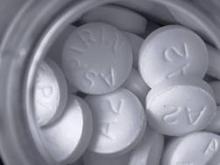LONDON – Plain old aspirin proved far and away the most effective of the various agents used for prophylaxis of migraine with aura in an Italian study, with 86% of aspirin-treated patients reporting at least a 50% reduction in frequency of attacks.
"We found the probability of treatment success with acetylsalicylic acid at 300 mg once daily was about six times greater than with other prophylactic agents," Dr. Lidia T. Savi reported at the European Headache and Migraine Trust International Congress.
Dr. Savi, a neurologist at the University of Turin (Italy), presented a retrospective analysis of 194 consecutive patients at the university’s headache center who were placed on prophylactic therapy for migraine with aura. Ninety were on aspirin at 300 mg/day. The rest were on various widely used prophylactic medications, with propranolol and topiramate topping the list.
The primary end point was treatment success as defined at week 32 by at least a 50% reduction in the frequency of attacks of migraine with aura, compared with baseline. Eighty-six percent of patients on aspirin for prophylaxis met this end point; indeed, 41% of the aspirin-treated group also met the more rigorous standard of ‘extremely improved’ as defined by a 75% reduction in attack frequency. Fourteen percent of patients were rated unimproved.
In contrast, 46% of patients on prophylactic agents other than aspirin were unimproved. Only 17% were judged extremely improved and 37% were improved.
Aspirin prophylaxis at the 300 mg dose was, as expected, very well tolerated, with nobody switching to another agent within 32 weeks due to side effects. Moreover, treatment success rates in the aspirin group were the same at 16 weeks as at 32 weeks, so patients and their physicians can expect to see evidence of response to prophylactic aspirin in a relatively short time, Dr. Savi continued.
In a multivariate analysis adjusted for age, gender, disease duration, and other variables, only prophylactic aspirin was independently associated with a positive treatment response. Patients on prophylactic aspirin were an adjusted 6.3-fold more likely than were those on other drugs to have at least a 50% reduction in migraine with aura frequency.
The prevalence of migraine with aura in the general population is estimated at 1%-5%. Most affected patients find the aura more disturbing and disruptive than the subsequent head pain.
Prior studies comparing prophylactic agents for migraine with aura have typically reported aspirin to be only mildly effective. However, these studies often contained only small numbers of patients and muddied the waters by mixing together subjects who had migraine with aura and those who had migraine without aura, according to Dr. Savi.
A double-blind, placebo-controlled study with a larger patient sample will be needed to confirm the Italian findings, she added.
Prophylactic aspirin’s mechanism of benefit in migraine with aura isn’t known. But the disorder has been linked to platelet dysfunction, and Dr. Savi’s hypothesis is that daily aspirin prevents migraine with aura attacks by curbing formation of microemboli.
Audience member Dr. Jean Schoenen of the University of Liege (Belgium) asked how many patients in the Italian series were on lamotrigine, which he considers the best agent for prevention of attacks of migraine with aura. Dr. Savi replied that none were. She said she and her colleagues seldom prescribe lamotrigine (Lamictal) anymore because they’ve found the discontinuation rate is so high.
Dr. Savi reported having no financial conflicts.



